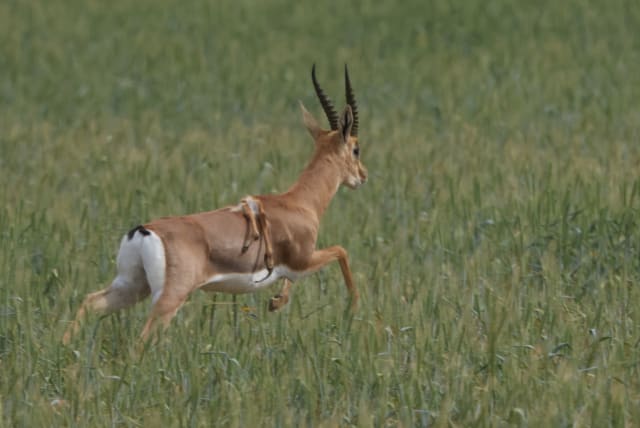First of its kind: Six-legged gazelle spotted in Israel's western Negev

While gazelle sightings in Israel are already uncommon due to their endangered status, this one is reported to be the first of its kind to be spotted.
A gazelle with an extra pair of front legs growing on its back was discovered two weeks ago by an army reservist in the Nahal HaBashor nature reserve in the western Negev.
It is the first time such a growth has been found on an Israeli gazelle, an endangered species for whom Israel, home to about 5,000 in the wild, is the last stronghold.
The gazelle was spotted by Nir Leichter, an army reservist who saw the gazelle while stopping at the nature reserve for coffee. Leichter photographed the gazelle, and sent it to the Society for the Protection of Nature in Israel (SPNI), noting “something strange on its back.”
The picture prompted an inquiry led by Amir Balaban, SPNI's Director of Urban Nature, and the team in charge of the Gazelle Valley in Jerusalem, an urban oasis home to a herd of wild gazelles.
The inquiry found that the strange growth was in fact an extra pair of front legs, growing from the gazelle’s back. Balaban immediately rushed to the field to document the rare phenomenon and discovered that “the gazelle, which began its life in the Kissufim area as a fawn in 2021.. [has] managed to lead an impressive life in the Nahal HaBasor reserve.
“Contrary to expectation,” Balaban found, “the gazelle is healthy, strong, and has three female gazelles and a fawn from the previous fall. He has been seen hosting the females in the fields and the extra legs on his back pose no challenge to him.”
Spring is peak calving season for Israeli gazelles, and Balaban noted that at this time of year, one might come across fawns. “If you encounter a fawn hiding in the field,” he said, “it is not an orphan. In the first few weeks,” he explained, “the deer hide the fawns from predators.”
“Move away immediately,” Balaban said, “without leaving any odor marks or residue to avoid attracting predators that will devour the fawn. Chances are that the gazelle is watching from afar and will come to treat the fawn every few hours.”
Israeli gazelles face multiple dangers
As for the situation of Israeli gazelles generally, right now, SPNI and other organizations are “fighting to save every remaining open space and ecological corridor,” the group said in a statement, “while at the same time trying to improve the planning processes to that development will allow significant ecological transitions.”
“There is still a lot of work to be done,” Balaban said, “such as improving areas defined as open spaces, [but] in practice blocked by fences, infrastructure, and more. Another major issue for gazelles is poachers, who hunt them mainly for the purpose of trading their meat.”
Balaban noted another issue is “the extreme increase in stray dogs and jackals, which prey on the gazelles and their fawns.”
Jerusalem Post Store
`; document.getElementById("linkPremium").innerHTML = cont; var divWithLink = document.getElementById("premium-link"); if (divWithLink !== null && divWithLink !== 'undefined') { divWithLink.style.border = "solid 1px #cb0f3e"; divWithLink.style.textAlign = "center"; divWithLink.style.marginBottom = "15px"; divWithLink.style.marginTop = "15px"; divWithLink.style.width = "100%"; divWithLink.style.backgroundColor = "#122952"; divWithLink.style.color = "#ffffff"; divWithLink.style.lineHeight = "1.5"; } } (function (v, i) { });

